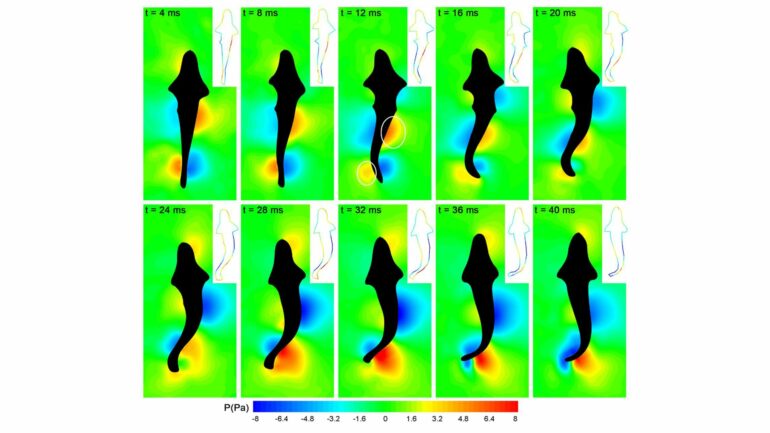Swimming in complex underwater environments, fish are unmatched when it comes to motion control and flexibility. For decades, researchers have been inspired to copy nature’s most gifted swimmers to optimize underwater vehicle propulsion and maneuverability.
Although the relation between the movement of the tail, or caudal fin, and the transient shapes and motion of the water environment is well known in fish mechanics, there has been little focus on how pressure fields affect thrust generation and control to propel fish.
In Physics of Fluids, researchers at the Harbin Engineering University in China showed that fish, through precise control of body fluctuations, generate movable vortex pairs of high- and low-pressure regions that enable them to swim. The findings provide the groundwork in the design of flexible structures for a high-performance underwater bionic propeller.
The researchers used particle image velocimetry and high-speed cameras to analyze the spontaneous swimming of zebrafish in a tank. A fish accelerates when it bends its caudal fin—attached to the vertebral column—to one side and then returns to the neutral position as the fish straightens its body. In this completion of a single tail swing, the researchers discovered the formation of two vortex cores at the wake spinning in opposite directions.
These cores constitute a low-pressure and high-pressure region on opposite sides of the fish. The researchers found the pull generated by the low-pressure area and the thrust produced by the high-pressure area together provide the propulsion power of the zebrafish.
The movement of these high- and low-pressure regions jointly promoted the acceleration of the fluid mass backward while pushing fluid outward at the tip of the caudal fin. When the fish body was J-shaped, the high-pressure area slid to the rear of the caudal fin, and the low-pressure area slid to the front of the caudal fin.
The caudal fin used the low-pressure area to drive the fluid toward the body and generate a vertical upward pull on the fin. The high-pressure area pushed the fluid away at the crest and generated an upward thrust on the caudal fin. Repetition of this process enabled the zebrafish to move continuously.
“The entire zebrafish in the swimming process is regarded as a body wave,” co-author Yang Han said. “Whether they accelerated forward or changed directions, the fish maintained a wavelike motion at all points of the body from the start of movement.”
More information:
“Hydrodynamic analysis of propulsion process of zebrafish”, Physics of Fluids, aip.scitation.org/doi/10.1063/5.0076561
Provided by
American Institute of Physics
Citation:
Fish generate movable pairs of vortices to propel them forward like body waves (2022, February 22)
